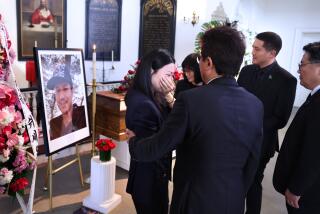Surgery May Help Boy Stand His Ground : Medicine: The rearrangement of muscles and ligaments and the removal of bone offer teen-age sufferer of cerebral palsy a chance to leave his wheelchair.
- Share via
In Korea, 16-year-old Seung Bok Kim grew up with a fear of “sliding.”
“The main thing he talks about is sliding around,” said Ann Wiener, who is Kim’s sponsor parent during his visit to Los Angeles. “I’m not exactly sure what that means, but every day he’s been in this country, he looks at me with a sad face and says, ‘No sliding, no sliding.’ ”
When the ground is wet and you have to balance on crutches because your legs and feet have been deformed by cerebral palsy, you don’t walk, you slide, Kim explained in Korean as he prepared to leave Orthopaedic Hospital near downtown Monday.
“When there is ice or rain or even in the bathroom, it gets slippery,” Kim said en route to the Wiener home in La Crescenta. “I’d try to walk a little and I would spend most of my time on the ground. Falling down and getting up; doing the same thing over and over again. Some days, I’d be scratched up and bloody from all the falling.”
And so, Kim, who was raised in an orphanage for handicapped children in Seoul, opted to spend most of his childhood in a wheelchair.
Last week, the youth, who has been going by the name “Sammy” since arriving here last fall, received an unexpected operation to correct some of the deformities caused by his affliction.
If recovery goes as planned, he soon may be able to walk with crutches without falling, said the surgeon, Dr. Wilfred Krom.
Cerebral palsy is the most common long-term disability in American children, Krom said. The condition is created by a brain injury during the prenatal period or during the first two years of life, Krom said. Because of the injury, muscles tend to overdevelop, become spastic and exert excessive pressure on bones, which leads to deformities, he said.
The operation--during which a part of Sammy’s femur was removed and ligaments and muscles in his right arm, hips, knees, ankles and feet were rearranged--was “relatively routine stuff for kids with cerebral palsy,” Krom said.
The surgeon added that the operation was probably within the capabilities of physicians and hospitals in Korea.
But, without money or family, the chances of Sammy seeing an orthopedic specialist were few, Wiener said.
The cost of the surgery was about $25,000, Wiener said. A fund-raising foundation at the hospital paid facility expenses, doctors waived surgery fees and several Los Angeles-area Korean groups raised about half the money needed for Sammy’s six months of recovery and rehabilitation, she said.
A Korean-owned painting company, which was working at the hospital and happened to hear of Sammy’s condition, joined with two Korean-American churches, the Rotary Club of Koreatown and several individuals to donate about half of the $15,000 needed to pay for nursing care, physical therapy, bracing and rehabilitation equipment. The hospital’s International Children’s Program is continuing to solicit donations.
Sammy’s recovery period will last about four months, Krom said. After six weeks, the leg casts will be removed, then he will undergo at least three months of physical therapy.
“His body has gone from being bent up like a ‘Z’ to a position we hope will be straight and tall,” the doctor said. “He will still have cerebral palsy, but now he has the chance to reacquaint himself with his extremities.”
As he was waiting to go home with Wiener, her husband Paul, and their son, Scott, 23, Sammy added that many of the questions that dogged him through childhood seem to be getting answered.
He said he used to ask: “Why am I different from other children who have parents to care for them?”
But the question that came up most often, he said, was, “Why can’t I walk?”
More to Read
Sign up for Essential California
The most important California stories and recommendations in your inbox every morning.
You may occasionally receive promotional content from the Los Angeles Times.













